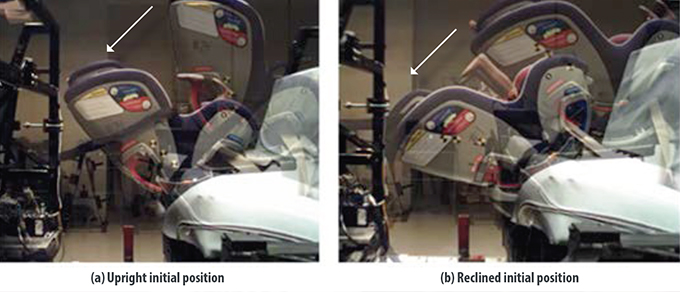Principal Investigator: John Bolte, PhD, The Ohio State University
Below is an executive summary of this project. Please note that this summary describes results and interpretation that may not be final. Final interpretation of results will be in the peer-reviewed literature.
Rear-facing child restraint systems (RF CRS) are recommended for children from birth until they physically outgrow the weight or height limits of the restraint, which typically happens around 2 years of age. RF CRS are designed to absorb and distribute crash forces through the child’s back and into the CRS, yet it is difficult to establish an ideal recline angle (defined as the angle the CRS seat back is from vertical) due to the variety of ages and sizes of RF CRS occupants. The goal of this project was to optimize the recline angle of RF CRS in frontal crashes to provide ideal crash safety while considering the differing physiological needs of children in various stages of development.
After reviewing published medical data, recline angles were identified that were considered safe with respect to bradycardia and apnea risk in normal transport for newborns, particularly those born prematurely (37 weeks and earlier). In order to determine the optimal recline angle that balanced safety during normal transport and occupant protection during collisions, researchers conducted frontal sled tests on a vehicle bench seat to examine the responses of anthropomorphic test devices (ATDs), or crash test dummies, ranging from newborn to 3-year-old, across a range of RF CRS recline angles. Both CRS kinematics and ATD injury criteria were measured. Investigators considered real-world CRS misuse data to recreate realistic scenarios, such as CRS recline angles which are too upright and/or CRS with loose harness straps.
The sled test data indicated that CRS which initially positioned the ATD in a more horizontal recline position tended to result in lower head injury measures, larger chest accelerations, and greater recline angles at the point of maximum rotation as compared to CRS which positioned the ATD initially in more upright seated positions. Of these variables, the initial recline position most significantly influenced the maximum recline angle of the CRS; however, the effect on head injury measures and chest accelerations was not as significant. Larger ATDs experienced higher neck tensions than smaller ATDs possibly because of their greater head mass. Neck tension did not appear to vary according to initial recline angle.
It is important to note that this study was conducted on a sled test with a bench seat that had no vehicle interior. Results of this study suggest that more reclined initial positions could result in more horizontal recline angles at the point of maximum rotation and/or forward movement of the CRS in the event of a crash thereby increasing injury risk. Future work should consider how the kinematics of the CRS may interact with a vehicle’s interior and potentially increase the risk of injury. While smaller infants who are born prematurely (before 37 weeks) require a more reclined angle to prevent bradycardia and/or apnea, as children grow older but remain rear-facing, considerations should be made to seat toddlers in a more upright rear-facing position to prevent CRS over-rotation and to decrease the risk of contact with the vehicle’s interior.
Project Team Members
Julie Bing, MS, The Ohio State University
IAB Mentors
Keith Nagelski, Britax Child Safety, Inc.; Eric Dahle, Evenflo Company Inc.; Mark LaPlante, Graco Children’s Products Inc.

